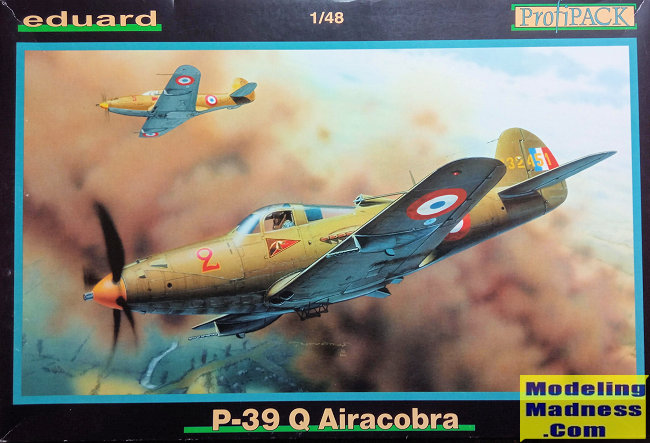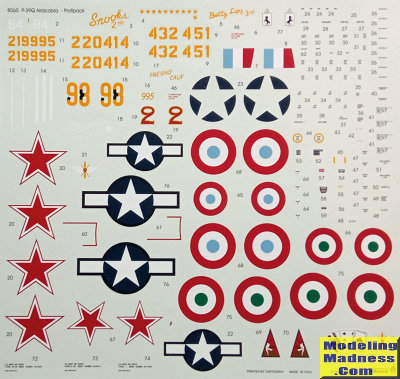
| KIT #: | 8065 |
| PRICE: | $35.00 when new |
| DECALS: | Four options |
| REVIEWER: | Spiros Pendedekas |
| NOTES: | Profipack |

| HISTORY |
Being one of the principal
American fighters in service when the United States entered WWII, the P-39 had
an innovative layout, with the engine installed in the center fuselage behind
the pilot, driving the propeller via a long shaft and was also the first fighter
fitted with a tricycle undercarriage.
Although the (cursory, as it turned out) decision not to equip the engine with
an efficient turbo-supercharger had a deleterious effect in high altitude
performance (it being the main reason this very fine machine was rejected by the
RAF), the Airacobra was a really good performer at altitudes where the engine
allowed it to exhibit its full potential. Apart from the Pacific Theater, this
potential was even more clearly shown at the Eastern Front, where most air
combat took place at medium and lower altitudes, with the Airacobra enabling
individual Soviet pilots to collect the highest number of kills attributed to
any U.S. fighter type flown by any air force in any conflict
Other major users of the type included the Free French, the Royal Air Force, and the Italian Co-Belligerent Air Force, with a total of 9,588 units built.
| THE KIT |
 Eduard
came in 2000/2001 with their modern 1/48 Airacobra mold in no less than five
editions, covering the vast majority of the type’s sub variants. This successful
kit has been reboxed another 15 times ever since in various forms (Profipack,
Dual Combo, Overtrees, Weekend), even twice by Accurate Miniatures and once by
Academy. The subject kit is the initial 2001 release P-39Q ProfiPack version,
bought sometime in 2005 at a price which looked very sensible for what was
offered.
Eduard
came in 2000/2001 with their modern 1/48 Airacobra mold in no less than five
editions, covering the vast majority of the type’s sub variants. This successful
kit has been reboxed another 15 times ever since in various forms (Profipack,
Dual Combo, Overtrees, Weekend), even twice by Accurate Miniatures and once by
Academy. The subject kit is the initial 2001 release P-39Q ProfiPack version,
bought sometime in 2005 at a price which looked very sensible for what was
offered.
The kit came in the usual good quality small top opening Eduard box, carrying a
very attractive box art of two Armée de l'Air Airacobras in flying status,
seemingly during a strafing mission. Upon opening the box, I was greeted with 86
beige styrene parts arranged in four sprues, a clear sprue, a nice PE fret, a
film with printed instrument faces, a set of vinyl masks and a beautifully cast
nose weight. Not all styrene parts are to be used for the specific version,
since most of the sprues are common with the other versions. Molding is
first class and practically flash free, with finely recessed panel lines.
The cockpit is beautifully rendered, including a plethora of details found at
the real thing. PE is extensively used for beefing up the looks, with the
instrument panel itself having to be constructed solely from PE and using the
film instruments provided. Since the use of PE (and film) might sound
attractive, it might also be a handful to tackle, or even a non-preference for a
number of us: no worries, as the basic styrene kit is fully standalone, not
relying on PE, so, if we prefer, we can use the classic styrene parts from the
sprues which are very nicely done. A couple of decals are used to represent some
console faces. The seat belts are PE and are wonderfully done.
Landing gear is very well represented, the bays are fully boxed and detailed,
whereas weighted or unweighted wheels are provided. The distinctive radiator/oil
cooler inlets and exits are nicely rendered, featuring optional PE inlet and
outlet meshes and exit louvers. The exhausts are equally well done. Two prop
options are provided, three or four-bladed, depending on the version you build.
Finally, the wing gun pods look good with the ejector chutes molded on.
As it has been reported, the wing seems thicker in profile than it should be,
the effect being noticeable at the leading and trailing edges: I believe, some
judicious “angled” sanding at the affected areas once the wing is assembled will
vastly improve looks.
Transparencies are excellently molded and crystal clear. The cockpit entry doors
are provided as single piece clear parts that have to be painted. Instructions
are equally great, coming to the form of two pamphlets, containing a short
history of the type, a parts diagram, with the construction nicely spread in 11
clear and concise steps.
 The nice PE
fret provided will substantially beef up the looks, detail-wise. The cast weight
provided is really wonderful,, since it not only ensures that you will not end
with a tail seater (as this and every other Airacobra model is a prime candidate
for), but also, with its lower part nicely formulated, it offers a correct,
homogeneous look at the nose bay area.
The nice PE
fret provided will substantially beef up the looks, detail-wise. The cast weight
provided is really wonderful,, since it not only ensures that you will not end
with a tail seater (as this and every other Airacobra model is a prime candidate
for), but also, with its lower part nicely formulated, it offers a correct,
homogeneous look at the nose bay area.
No less than four interesting schemes are provided, for an Italian, a French, a
U.S. and a Russian example. Decals are excellently done by Cartograf and show no
signs of aging (though you can never know until you use them).
Instructions want you to first assemble the cockpit with the nose bay under it,
then, together with the weight provided, trap them between the fuselage halves.
The wing is next assembled and attached, followed by the tail planes, the main
landing gear, the gun pods, the external stores (tank or bomb) and the nose
landing gear. The exhausts are then to be attached, followed by the canopy, the
entry doors, some small “detailing” bits and, finally, assembly and installation
of the correct for your version prop, ending a straightforward build that might
present a level of complexity, mostly due to the use of PE.
| CONCLUSIONS |
Though launched more than 20
years ago, this is still a very good kit of the iconic Airacobra. Apart from the
thicker main wing profile (which can be easily tackled by some judicious sanding
of the leading and trailing edges at an angle) general shapes of parts are spot
on, panel lines are wonderfully engraved, molding is superb, details are all
over plentiful, clear parts are excellent, instructions are superb and four very
interesting schemes are provided with the Cartograf decals looking spotless.
The nice PE fret is a very welcome addition, promising to beef up your Airacobra,
detail wise, with the option to use PE to the extent you like, since the basic
kit is fully standalone, with the relative styrene bits equally nicely done. The
vinyl masks are another welcome addition and the cast nose weight is supreme.
Though it is true that the newer Hasegawa Airacobra is excellent, the Eduard, in
its all versions (Profipack or simpler “weekend” and so on) is by all means a
great kit, offered at practically bargain prices, definitely worth tackling.
Happy Modeling!
Spiros Pendedekas
April 2023
Copyright ModelingMadness.com. All rights reserved. No
reproduction in part or in whole without express permission.
If you would like your product reviewed fairly and
fairly quickly, please
contact
the editor or see other details in the
Note to
Contributors.